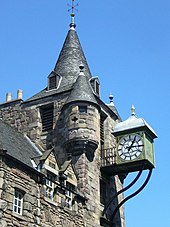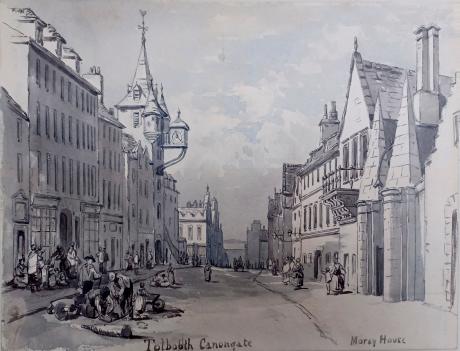inscribed " Tolbooth Canongate Moray House" a page from an album inscribed in the frontispage "F W Staines 3 Uplands St Leonards on Sea"
Amelia Jackson, Nee Staines (1842 – 1925) and thence by descent
Canongate Tolbooth is a historic landmark of the Old Town area of Edinburgh, built in 1591 as a tolbooth, that is, the centre of administration and justice of the then separate burgh of the Canongate which was outside the Edinburgh town walls. It ceased to be a municipal building in 1856 and it is now occupied by The People's Story Museum and is protected as a category A listed building.
History

The tower of the tolbooth was built in 1591, and the block to the east of it at that time or slightly after, by Sir Lewis Bellenden, baron of Broughton and feudal superior of the burgh of Canongate and Lord Justice Clerk of Scotland. It served as the courthouse, burgh jail and meeting place of the town council.
Many Covenanters were held in the tolbooth in poor conditions in the 17th century and a riot took place in the building in May 1692. It ceased to be the meeting place of the burgh council when Canongate was annexed by Edinburgh in 1856.
In 1875 the City Architect, Robert Morham, extensively restored and remodelled the exterior. Internally the first and attic floors were combined to make a single floor, now The People's Story Museum.
The tolbooth was designed in the Scottish medieval style: it comprises a bell tower with a lower block to the east that contained the council chamber and courtroom. The tower has two bartizans with ornamental gunloops on either side of a clock, dated 1884 and manufactured by James Ritchie & Son, which is suspended over the Royal Mile by wrought iron brackets. Above the bartizans is a conical spire while at street level there is a round-arched pend that leads into Tolbooth Wynd. Architectural features of the east block include a stone forestair which leads to a door next to the tower, an oriel window, and four pedimented dormers by Morham, based on Gordon of Rothiemay's map of 1647, that replaced three piended ones.
To the east of the tolbooth, down the Royal Mile, is the Kirk of the Canongate and the Canongate Kirkyard.
The Moray House School of Education and Sport ('Moray House') is a school within the College of Arts, Humanities and Social Science at the University of Edinburgh. It is based in historic buildings on the Holyrood Campus, located between the Canongate and Holyrood Road.
The school offers academic programmes at all levels of higher education, including teacher education, Community Education, Digital Education, Language Education, Physical Education and Sports science.
The School has approximately 2000 students and nearly 500 academic and professional staff.
The school has existed in one form or another since the mid-19th century, joining the University of Edinburgh in 1998. The institution currently known as Moray House was originally opened as a normal school following the Disruption of 1843. Known as The Free Church of Scotland's Normal and Sessional School, it was originally located in Whitefield Chapel, and then in rooms below the Music Room in Rose Street. In 1848, the school moved to its current location in Moray House, in the Canongate.
From 1864 to 1907 its Rector was Maurice Paterson LLD.
In 1907, this institution merged with its Church of Scotland equivalent (the Church of Scotland Training College), and the Edinburgh Provincial Training Centre was formed; with the church training colleges subsumed within this organisation. The new teaching building opened at Moray House in 1931.
Moray House College of Education was officially formed in 1959.
In the early 1980s, Callendar Park College of Education, in Falkirk, was merged with Moray House.
In 1987, Moray House merged with the Dunfermline College of Physical Education based at Cramond, and continued to exist on two separate campuses (Holyrood and Cramond) until 2001. In 1991, the institute was linked with Heriot-Watt University, Edinburgh; and was retitled Moray House Institute of Education. On 1 August 1998, Moray House Institute of Education merged with the University of Edinburgh becoming its Faculty of Education.
Following internal restructuring of the University of Edinburgh in 2002, Moray House became known as the Moray House School of Education.
In August 2019, Moray House School of Education was renamed Moray House School of Education and Sport.

